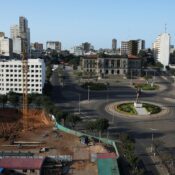
Exclusive: Sources say Iran’s top leader has been taken to a safe place
Authorities in Iran have taken Supreme Leader Ayatollah Ali Khamenei to a safe place because of increased security, according to Reuters. This comes a day after Israel killed the leader of the Lebanese group Hezbollah, which was backed by Iran, in a strike on Beirut.
Security measures for Iran’s top leader are the latest sign that the country’s leaders are getting tense after Israel attacked Hezbollah, which is Iran’s best-armed and best-equipped ally in the area.
Reuters reported this month that the Leaders of Iran’s Revolutionary Guards Corps (the Islamic Republic’s ideological guardians) told all of their troops to stop using any kind of communication device after Hezbollah’s use of thousands of pagers and walkie-talkies blew up.
The pager and walkie-talkie strikes were blamed on Israel by Lebanon and Hezbollah. Israeli officials neither denied nor confirmed their participation.
Two officials in the region who were informed by Tehran and told Reuters that Khamenei had been moved to a safe place also said that Iran was talking to Hezbollah and other regional proxy groups to figure out what to do next after Nasrallah disappeared.
Since the information was sensitive, the sources refused to give their names.
According to Iranian media on Saturday, Israel’s attacks on Beirut on Friday killed both Nasrallah and Abbas Nilforoushan, who was the deputy leader of the Revolutionary Guards. Since last year’s Gaza War and other cases of violence, other Revolutionary Guard leaders have also been killed.
Hezbollah will lead the fight in this region, according to Khamenei, in a statement released after Israel said Nasrallah had been killed.
His words in a separate statement, “The blood of the martyr shall not go unavenged,” also called for five days of grief to mark Nasrallah’s death.
Nasrallah’s death is a big loss for Iran because it takes away an important friend who helped make Hezbollah the focal point of Tehran’s network of Arab allies.
This group of regional friends, which Iran calls the “Axis of Resistance,” includes Hezbollah in Lebanon, Hamas in Gaza, Iran-backed militias in Iraq, and the Houthis in Yemen.
Since Oct. 7, when Hamas fighters stormed into Israel, the two countries have been at war for almost a year. Meanwhile, the Houthis have fired rockets at Israel and ships in the Red Sea and the Gulf of Aden off the coast of Yemen.
Firefights between Israel and Hezbollah have been happening across the border in Lebanon during the Gaza War. Hezbollah has said many times that it will not stop until there is peace in Gaza.
One Iranian security source told Reuters that after the pager and walkie-talkies attacks, the Revolutionary Guards were doing a large-scale operation to check all communication devices. According to him, most of these gadgets were either made by hand or came from China and Russia.
Officially, Iran was worried about Israeli agents getting inside, including Iranians working for Israel. A full investigation of staff has already started, focusing on middle-level and senior Revolutionary Guards members.
Additionally, on Saturday, Iranian President Masoud Pezeshkian said that the US had contributed to Nasrallah’s death by giving arms to Israel.
The statement carried by state media said, “The Americans cannot deny their cooperation with the Zionists.”
All Categories
Recent Posts
Tags
+13162306000
zoneyetu@yahoo.com


